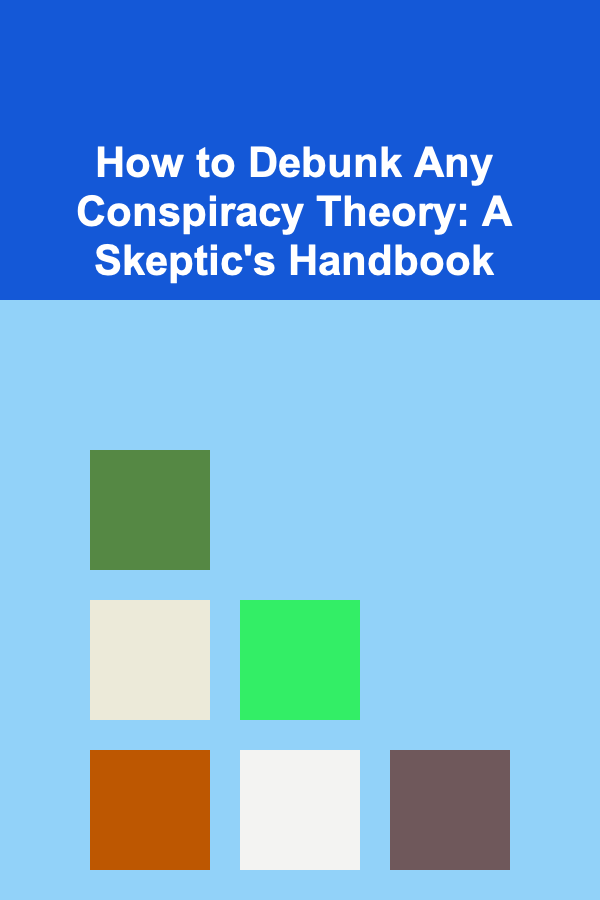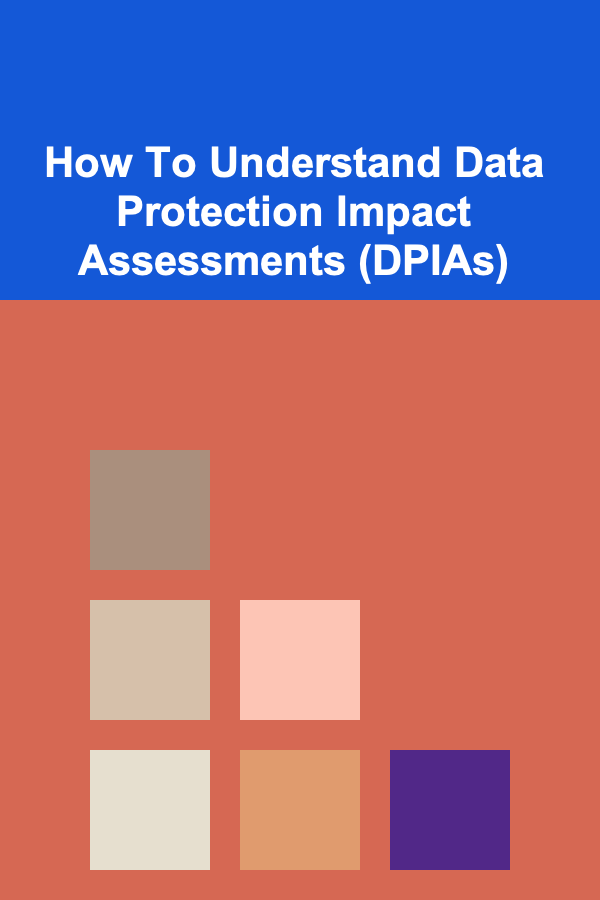
How to Debunk Any Conspiracy Theory: A Skeptic's Handbook
ebook include PDF & Audio bundle (Micro Guide)
$12.99$7.99
Limited Time Offer! Order within the next:

Conspiracy theories are alluring. They promise simple explanations for complex, often chaotic events. They offer us a sense of control over the unknown, and the feeling that we are privy to "hidden truths" that others fail to see. However, these theories often lack the rigorous evidence necessary to support them and can perpetuate misinformation, fear, and division. As skeptical thinkers, it is essential to understand how to debunk conspiracy theories effectively.
In this article, we will explore the steps to critically assess and debunk any conspiracy theory. These techniques can help you approach such topics with a rational, evidence-based mindset, and encourage others to consider alternative, fact-based explanations.
Understanding Conspiracy Theories
What is a Conspiracy Theory?
A conspiracy theory typically involves a belief or explanation that a group of people or organizations is secretly plotting to deceive the public or control events. These theories often offer a simplified narrative for complex phenomena, relying on the premise that those in power are intentionally hiding the truth.
While some conspiracies may have a kernel of truth, most conspiracy theories are based on a fundamental misunderstanding of facts, logical fallacies, or deliberate misrepresentation. They are rarely grounded in the kind of rigorous investigation and evidence gathering required by true scientific or journalistic endeavors.
Why Do People Believe in Conspiracy Theories?
There are several psychological and social factors that contribute to the widespread belief in conspiracy theories:
- Cognitive Biases: Humans are prone to various cognitive biases, such as confirmation bias (the tendency to seek out information that supports preexisting beliefs) and proportionality bias (the belief that large events must have large causes).
- Need for Certainty: In times of uncertainty, individuals may be drawn to simple, clear explanations that offer a sense of control or understanding.
- Mistrust of Authority: A deep-seated mistrust of governments, corporations, and other powerful institutions often fuels conspiracy theories.
- Social Influence: Social networks, including friends, family, and online communities, can play a significant role in spreading and reinforcing conspiracy theories.
Understanding these psychological dynamics is essential for both recognizing when someone is succumbing to a conspiracy theory and knowing how to effectively counter these beliefs.
The Skeptical Approach: How to Debunk a Conspiracy Theory
Debunking a conspiracy theory requires a methodical, evidence-driven approach. Here are the steps that can help you challenge these ideas:
2.1. Ask Critical Questions
The first step in debunking a conspiracy theory is to approach the theory with critical questions. These questions help to uncover the flaws and contradictions in the theory itself. Consider the following questions:
- Who benefits from this conspiracy? Conspiracy theories often involve secret groups or individuals with hidden motives. Ask who stands to gain if this conspiracy is true, and whether the alleged beneficiaries could realistically have the power and resources to pull off such a scheme.
- What is the evidence? A key feature of any credible theory is evidence. Ask for concrete, verifiable evidence supporting the claim. Conspiracy theories often rely on anecdotal evidence or selective interpretation of facts. True, reliable evidence should be consistent, reproducible, and open to peer review.
- Why is there a cover-up? If the conspiracy involves a cover-up, ask why the alleged perpetrators would go to such lengths to hide the truth. What are they gaining by keeping the conspiracy secret? Is it reasonable to assume that so many people involved in the conspiracy would remain silent?
- Is this theory consistent with known facts? Conspiracy theories often conflict with established facts. Compare the theory with the wealth of knowledge already available. Is there a more plausible, evidence-based explanation?
These questions create a foundation for dissecting the validity of the theory, revealing inconsistencies and encouraging others to think critically.
2.2. Analyze the Evidence
Once you've asked critical questions, the next step is to analyze the evidence being presented in support of the conspiracy theory. Many conspiracy theories rely on flawed or misinterpreted data.
- Corroboration: Examine whether the evidence presented by conspiracy theorists is supported by independent sources. Is the evidence corroborated by experts in the field? Is it based on reputable sources or dubious websites with questionable credibility?
- Bias and cherry-picking: Conspiracy theorists often use selective evidence that supports their claim while ignoring data that contradicts it. This is known as cherry-picking. Ask yourself whether the evidence presented is comprehensive and objective.
- Reproducibility: In scientific and factual investigations, evidence should be reproducible. This means that independent researchers should be able to arrive at the same conclusions using the same methods. If a conspiracy theory is based on unverifiable or anecdotal evidence, it is likely flawed.
- Logical Consistency: Conspiracy theories are often riddled with logical fallacies. Look for contradictions, oversimplifications, or false cause-and-effect relationships. A valid explanation will be internally consistent and logically sound.
Through a careful analysis of the evidence, you can identify where the conspiracy theory goes wrong and uncover the factual discrepancies that undermine it.
2.3. Consult Experts and Reputable Sources
Conspiracy theories often operate in the realm of uncertainty and misinformation. To debunk these theories, it's crucial to rely on authoritative sources and experts in the relevant fields. Experts use rigorous methodologies to gather data, form conclusions, and test hypotheses.
- Peer-reviewed literature: Many conspiracy theories are challenged or debunked by peer-reviewed studies and articles published in reputable journals. Consult databases like Google Scholar or PubMed to access credible academic sources.
- Subject-matter experts: Seek out experts in the field---whether it's history, science, or politics---who can provide context and clarification. These professionals often have specialized knowledge that can shed light on the facts behind the conspiracy theory.
- Fact-checking websites: Several reputable fact-checking organizations (e.g., Snopes, PolitiFact, FactCheck.org) have dedicated teams that investigate and debunk widely circulating conspiracy theories. Refer to these sites for well-researched and up-to-date debunkings.
Expert opinions and evidence-based sources can provide the clarity necessary to dismantle conspiracy theories.
2.4. Understand Logical Fallacies
Conspiracy theories are often built on a foundation of logical fallacies. By recognizing these fallacies, you can expose the flaws in the reasoning behind the theory.
Here are some common logical fallacies found in conspiracy theories:
- Ad hominem: Attacking the character or motive of the person making the argument rather than addressing the argument itself.
- False equivalence: Drawing a comparison between two things that are not truly comparable.
- Confirmation bias: Seeking out evidence that confirms preexisting beliefs while ignoring evidence that contradicts them.
- Appeal to ignorance: Arguing that a claim is true because it has not been proven false, or vice versa.
- Slippery slope: Arguing that one event will inevitably lead to a series of negative consequences without evidence to support this claim.
Being able to spot and understand these fallacies is a powerful tool when confronting conspiracy theories.
2.5. Provide Plausible Alternatives
A common reason people believe in conspiracy theories is the sense that the "official" explanation doesn't make sense or feels incomplete. To debunk a conspiracy theory effectively, it's helpful to present a more plausible alternative explanation based on evidence.
For instance, if someone is convinced that the moon landing was faked, provide them with evidence of the Apollo missions, including photographs, rock samples, and testimony from thousands of scientists and astronauts. By offering an alternative narrative supported by solid evidence, you challenge the theory and give the person a reason to reconsider their beliefs.
2.6. Engage with Empathy and Respect
It's crucial to approach people who believe in conspiracy theories with empathy and respect. Debunking a conspiracy theory is not about humiliating the individual or belittling their beliefs; it's about guiding them toward critical thinking and helping them consider alternative, evidence-based explanations.
- Avoid confrontation: Confrontational or aggressive debunking methods often backfire. When people feel attacked or ridiculed, they are less likely to change their beliefs.
- Foster open dialogue: Encourage open discussion and ask questions that prompt reflection. People are more likely to reconsider their views when they feel heard and understood.
- Provide sources: Instead of simply dismissing the theory, provide the person with credible sources, articles, or videos that offer a more reasonable perspective.
Respectful dialogue creates a more conducive environment for critical thinking and encourages individuals to question their beliefs without feeling threatened.
2.7. Stay Informed and Educate Others
Finally, staying informed about common conspiracy theories and how they spread is essential for effectively debunking them. The more you know about the history of conspiracy theories, common tropes, and the psychological factors that contribute to their appeal, the better equipped you will be to challenge them.
Educate others in your community about critical thinking, logical reasoning, and the importance of skepticism. By promoting rational discourse and educating those around you, you can help reduce the spread of misinformation and contribute to a more informed society.
Conclusion
Debunking conspiracy theories requires a combination of critical thinking, skepticism, and empathy. By asking the right questions, analyzing evidence, consulting experts, understanding logical fallacies, and presenting plausible alternatives, we can dismantle the false narratives that underlie these theories. Engaging with those who believe in conspiracies with respect and an open mind is essential to fostering productive dialogue and encouraging rational thinking.
Ultimately, by adopting a skeptical mindset and promoting evidence-based reasoning, we can help reduce the influence of conspiracy theories and encourage a more informed, thoughtful society.

How to Label Pantry Items for Quick Identification
Read More
How to Provide Proactive Customer Support: A Checklist for Preventing Issues
Read More
How to Use Deep Learning for Passive Income in the Digital Marketplace
Read More
Unlocking Success as a Tax Consultant: A Comprehensive Guide to Tax Advisory Services
Read More
How To Understand Data Protection Impact Assessments (DPIAs)
Read More
How To Engage with Local Art and Music
Read MoreOther Products

How to Label Pantry Items for Quick Identification
Read More
How to Provide Proactive Customer Support: A Checklist for Preventing Issues
Read More
How to Use Deep Learning for Passive Income in the Digital Marketplace
Read More
Unlocking Success as a Tax Consultant: A Comprehensive Guide to Tax Advisory Services
Read More
How To Understand Data Protection Impact Assessments (DPIAs)
Read More